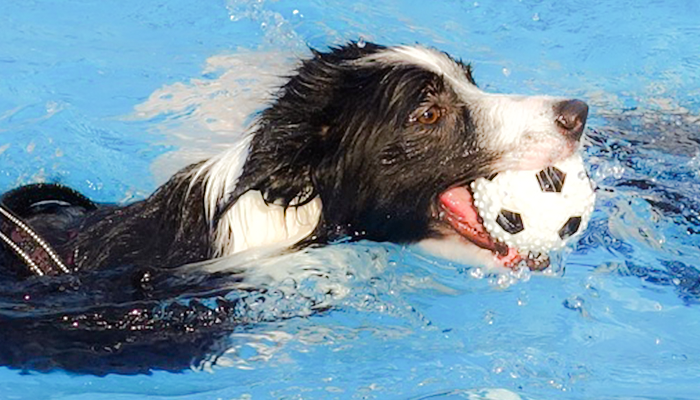Hydrotherapy for Dogs: The Weight Of Water And How It Helps Dogs
Water has unique properties which make it a wonderful exercise medium for canine patients. Most dogs love it as much as I do!
The Weight of Water, by Anita Shreve, is one of my favorite books. It’s the kind of book I can read over and over again. It combines all of my favorite things: history, suspense, relationships, islands, sailboats, and water. I love water, being near it, on it, in it. And, as a physical therapist, I love using it for therapy and rehabilitation.

Benefits of hydrotherapy
Aquatic therapy, also called “hydrotherapy,” using pools, has gained popularity in the canine rehabilitation field over the past 8-10 years.
Water offers warmth, buoyancy, and resistance.
Water is a relaxing and supportive medium that facilitates movement and strengthening weakened muscles. It is especially beneficial when multiple parts of the animal’s body are having a problem. In addition to pools, your dog can benefit from hydrotherapy in
- whirlpools
- bathtubs
- lakes
- ponds
- streams, and underwater treadmills
Water exercise
The benefits of water exercise and swimming include:
Pressure
The hydrostatic pressure of the water helps support balance and weak limbs so that a dog can move without falling
Buoyancy
The upward thrust of water, takes the pressure off of sore painful joints affected by arthritis or healing from a fracture
Cohesion
Cohesion, or the binding force of water molecules adhering to each other, provides resistance for strengthening. When the body moves through the water, it requires force to separate the molecules.
Conductivity
Conductivity, having high specific heat and temperature conductivity so that water is able to heat or cool the body core rapidly.

Precautions and contradictions
Consult your veterinarian before starting any swim or aquatic program, whether related to medical or recreational purposes. Although the benefits are great, you should be aware of precautions and contraindications when considering aquatic therapy for your dog:
- Post-surgery, incisions should be closed, sealed, and dry prior to any water applications. That prevents infection or the possible spread of bacteria. Incisions may not be fully healed internally yet. But as long as they have “sealed,” it should be safe to swim.
- Some canine breeds may be frightened of the water and could become agitated, thrash about, and potentially harm themselves. Don’t force such animals to undergo the therapy.
- Pool activity should be supervised at all times.
- Diarrhea, bowel and bladder incontinence, bleeding, vascular disease, heart, or lung conditions are contraindications.
- Hydrotherapy is contraindicated for medical or health conditions that can be negatively affected by heat and humidity.
- Laryngeal paralysis with tie-back surgery is a contraindication for swimming. The larynx would be unable to close if the head submerged underwater and drowning could occur.
Choosing a swimming facility
Now, here are some general guidelines to consider when choosing a swimming facility for your dog:
- The water temperature should be between 75-80 degrees in the winter months.
- Chemical levels should be measured and balanced daily. Skimmers must be cleaned several times a day, and the pool should be vacuumed and back washed as needed.
- Staff members should be familiar with the basic anatomy and medical conditions of dogs and always be present.
- Dogs should be required to wear life vests. Leads may be attached to the life vest to provide assistance and control for the swim.
- The facility must be open and willing to collaborate with your veterinarian and physical therapist.
- The pool should have a ramp with treads and side walls or a mechanical lift.
- Bathing stations should be provided if the pool is chlorinated, along with a place to dry the dog. Drying is particularly essential during cold weather.
Individual considerations
Swim programs vary from dog to dog.
It is essential to start with a smaller amount of swimming (10-15 minutes). Err on the side of caution, especially with the first visit or 2. You can expect a dog to show some fatigue for a few hours after exercise. However, they should not be exhausted for a whole day.
The second swim is longer, adding 5 minutes, and gradually working up to 30 minutes. You and the staff should watch for special parts of the swim that seem challenging. For example, a dog that has had cruciate surgery usually has trouble making turns in the pool initially. Balls, floating noodles, toys, and verbal cues can be used to assist them in making turns.
Underwater treadmills
Another form of canine hydrotherapy is the underwater treadmill. An underwater treadmill is an enclosed and self-contained unit that allows a dog to walk partially submerged in water.
These units are usually found at rehabilitation facilities and physical therapy offices that specialize in animals. Besides sharing the physical medium of water, underwater treadmill walking offers a very different form of exercise from swimming.
The units have controls that alter the treadmill speed, depth, and temperature of the water. A higher speed of the treadmill, as well as the use of air jets increases resistance. These adjustments allow a therapist to systematically control and reproduce the exercise parameters and objective measurements of the dog’s progress.
I will provide more information on underwater treadmill exercise and compare it to land treadmill walking in a future article. Stay tuned!
Related articles:
Treadmills for Dog PT: A Comparison of Canine Treadmills
Further reading:
How Hydrotherapy and Swimming Can Benefit Dogs

